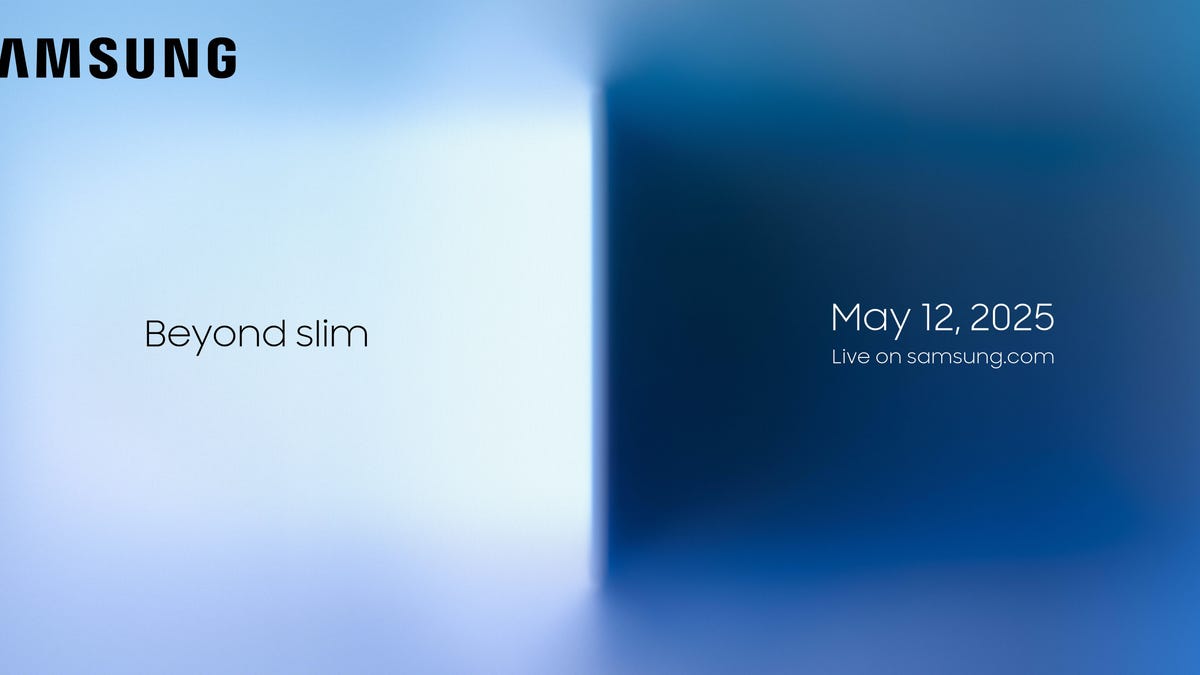Technologies
Samsung’s Superslim Galaxy S25 Edge Is Finally Making Its Debut. Here’s How to Watch
The long-awaited phone is set to be unveiled during a virtual Unpacked event. Here’s everything to know and how to tune in.

At long last, the superthin Galaxy S25 Edge that Samsung teased earlier this year is slated to make its official debut. The company will showcase the phone, and reveal all the highly anticipated specs, at a virtual Unpacked event on Monday, May 12.
Samsung introduced the S25 Edge at its January Unpacked event, and had models of the phone on display, but no one could touch or get too close to them. The company had a similar hands-off display at Mobile World Congress in Barcelona in March. At last, it appears we’re one step closer to seeing just how thin — and hopefully light — the latest addition to the Galaxy lineup is.
How to watch the Galaxy S25 Edge unveiling
Samsung’s Unpacked event for the S25 Edge will be fully virtual and will be held on Monday, May 12, at 8 p.m. ET (5 p.m. PT).
The event will be livestreamed on Samsung’s YouTube channel, on Samsung.com and on the Samsung Newsroom.
CNET will be covering all the live updates, so be sure to follow along.
The launch of the S25 Edge comes about three months after the release of the baseline Galaxy S25, S25 Plus and S25 Ultra.
What features will the S25 Edge have?
When Samsung first teased the Galaxy S25 Edge, details were slimmer than the device itself. There have been plenty of rumors, though, primarily relating to the phone’s battery and camera. With less space, just how much battery capacity and camera specs could Samsung pack in?
A leak from German tech blog WinFuture earlier this month suggests the S25 Edge will have a 3,900-mAh battery, which is less than both the baseline S25’s 4,000-mAh battery and the S25 Plus’ 4,900 mAh. We’ll have to see if these leaks align with what Samsung unveils on Monday, and, if true, whether the company manages to improve battery efficiency so you don’t really feel that difference.
Regarding the camera, Samsung’s display models showed two lenses on the back. Subsequent rumors have suggested a 200-megapixel wide camera paired with a 12-megapixel ultrawide camera. Samsung has remained quiet on any specifics until now, but confirmed in a post Wednesday that the S25 Edge will indeed feature that 200-megapixel wide camera.
«And thanks to Galaxy AI, the camera transforms into a smart lens that helps recognize what matters to create new memories,» Samsung added. AI capabilities will extend to photo editing as well, it says.
Other rumors from leaker Evan Blass suggest the S25 Edge will weigh 163 grams, measure 5.8mm thick and feature a titanium bezel. It could also be equipped with a Snapdragon 8 Elite for Galaxy chip. Blass has also suggested the phone will sport a Corning Gorilla Glass Ceramic 2 display, which Samsung confirmed in an update on Thursday, calling the cover «sleek yet strong.»
Additional rumors suggest the Galaxy S25 Edge could have a 6.7-inch AMOLED display with a 2,130 x 1,440 resolution, 12 GB of RAM and 256GB or 512GB of storage. Again, we’ll have to see what the official specs are from Samsung come May 12.
Why is Samsung making a thin Galaxy phone?
So, why would someone want a thin phone anyway?
It appears many phone makers, from Samsung to Apple to Oppo, are eyeing slim phones as the next design iteration to lure in potential customers. Oppo released its super-thin Find N5 foldable earlier this year, which it calls the «world’s thinnest book-style foldable,» measuring just 8.93mm thick when closed and 4.21mm thick when opened. Apple is rumored to be developing an «Air» version of the iPhone 17, a thinner (and presumably lighter) version of its handset. At MWC 2025, phone-maker Tecno showed off its Spark Slim phone concept, a handset measuring 5.75mm thick (skinnier than a standard pencil) and weighing only 146 grams, according to the company.
But thin phones have a big hurdle to overcome: Less space often means a smaller battery, scaled-back camera hardware and less storage. And as it so happens, those are three of the biggest considerations when people buy a new phone, according to a CNET survey from August.
«You can’t just be thin; you have to still have all the bells and whistles of a premium phone,» Nabila Popal, senior director of data and analytics at IDC, told me at MWC in March. «The question is, how are OEMs [phone makers] going to achieve that without compromising the other more important features like battery and camera?»
Popal also noted that the «slim is in» trend is largely an attempt by phone makers to differentiate their products. AI has also been a means for companies to make their offerings stand out, but that’s already become rather ubiquitous. An eye-catchingly thin phone could be one way to grab people’s attention — and dollars.
As Samsung sees it, it’s all about «merging flagship-level performance with superior portability,» it noted in its post, adding, «As our reliance on these devices grows, so do our expectations for them to be portable and lightweight without sacrificing power and innovation.»
Starting Wednesday, eligible customers who reserve the Galaxy S25 Edge can get a $50 Samsung credit toward the device.
We’ll see what’s in store come May 12.
Technologies
Live-Action ‘Call of Duty’ Movie Reportedly Being Co-Written by Taylor Sheridan
The Yellowstone co-creator will reportedly team up with Peter Berg on the Paramount film.

Yellowstone, Landman and, now, Call of Duty. Taylor Sheridan, co-creator of the aforementioned hit shows, will co-write Paramount and Activision’s upcoming live-action video game adaptation, according to a report from Variety on Thursday.
Peter Berg will also co-write and direct the movie, which was announced last month. Berg previously directed films including 2018’s Mile 22, 2012’s Battleship and 2013’s Lone Survivor, while Sheridan’s movie credits include 2016’s Hell or High Water and 2017’s Wind River. Berg, Sheridan and David Glasser will produce the Call of Duty film.
Don’t miss any of our unbiased tech content and lab-based reviews. Add CNET as a preferred Google source.
Call of Duty is a first-person shooter military video game series that debuted in 2003. CNET senior writer David Lumb calls it «arguably the biggest shooter franchise in gaming, with millions of players picking up every year’s new entry to the series.»
Lumb said the franchise is known for its bombastic single-player campaigns, which feature globe-spanning plots that rival those of the Mission Impossible films. «A Call of Duty movie has a lot of material to draw from,» Lumb said.
He also noted that Berg’s direction of Lone Survivor would fit the grim military heroism of Call of Duty, while Taylor Sheridan’s spate of neo-Western films and shows could lend a frontier adventurism to the film.
«Their collective works seemingly harmonize with the jingoistic pro-military tune of Activision’s shooter franchise — which is probably a good thing for Call of Duty fans,» Lumb concluded.
A release announcing Paramount and Activision’s film deal teased that it’ll be «designed to thrill its massive global fan base by delivering on the hallmarks of what fans love about the iconic series, while boldly expanding the franchise to entirely new audiences.» It didn’t include cast or plot information.
The update follows recent news that Sheridan is leaving Paramount for NBCUniversal. Paramount did not immediately respond to a request for comment.
Technologies
US Government Urges Total Ban of Our Most Popular Wi-Fi Router
Technologies
Animal Crossing Update Adds Lego Furniture, With a Switch 2 Version Arriving the Same Day
Fans of Animal Crossing will have a reason to go back to their island.

Animal Crossing fans just received a big surprise, and it’s not just a new content update. A Switch 2 version is on its way.
Animal Crossing: New Horizons will receive its first big update in three years, according to a post from Nintendo on Thursday. The update, labeled 3.0, will roll out on Jan. 15, the same day the Switch 2 version of the game will be available for purchase.
Released for the original Switch back in 2020, New Horizons was the first Animal Crossing game to come to a Nintendo console since 2008’s Animal Crossing: City Folk for the Nintendo Wii.
Nintendo regularly updated New Horizons for two years after its release, but stopped at update 2.0.6 released in November 2022. Two updates were added earlier in the year to prepare the game for playability on the Switch 2.
Animal Crossing 3.0 Update
In the 3.0 update coming on Jan. 15, a new hotel is opening. Players can help bring in guests to stay at the hotel by decorating guest rooms and dressing up mannequins to sell resort clothing.
For those who haven’t touched New Horizons in years, a Reset Service will be available. Players can have their island cleaned up, and items can be stored away or trashed for those who want a clean slate.
Players with a Nintendo Switch Online membership will have access to up to three islands, where they can explore and do as they please. These new areas are available on Slumber Island. It’s up to the player to decide how the island will look, what items or plants are on it and even which characters will be found on the island. Players can also invite friends to build it together.
New Horizons will feature special collaborations and Nintendo retro gear. Lego items will be available in the update for players to decorate their homes with or clothing to dress up their villagers with. Retro Nintendo consoles, such as the NES and Game Boy, can also be used as decorative items.
If the player has a Switch Online subscription, some classic titles such as Ice Climbers and Dr. Mario can be played via these in-game devices. There are also special items based on The Legend of Zelda and Splatoon series when players tap their amiibo from those games onto the Switch while playing.
Animal Crossing: New Horizons on Switch 2
Switch 2 owners can get in on the digital life game with Animal Crossing: New Horizons — Nintendo Switch 2 Edition. Not only will this new version come with updated graphics, including 4K resolution in TV mode, but it will also add special features that can only be done on the newest console.
One of the features is mouse controls for the Joy-Con 2. Players will be able to use the controller as a mouse to decorate indoors, create custom designs and write handwritten messages for the bulletin board.
Residents in the game can now be found by saying their name into the Switch 2’s built-in microphone while using the megaphone in the game. Multiplayer has also improved dramatically, with 12-player sessions available for those playing on the new edition, and CameraPlay is supported to allow players to see one another.
Animal Crossing: New Horizons for the Nintendo Switch 2 will be available for purchase on Jan. 15 for $65. Owners of the original Switch version of New Horizons can upgrade to the Switch 2 version for $5.
-

 Technologies3 года ago
Technologies3 года agoTech Companies Need to Be Held Accountable for Security, Experts Say
-

 Technologies3 года ago
Technologies3 года agoBest Handheld Game Console in 2023
-

 Technologies3 года ago
Technologies3 года agoTighten Up Your VR Game With the Best Head Straps for Quest 2
-

 Technologies4 года ago
Technologies4 года agoVerum, Wickr and Threema: next generation secured messengers
-

 Technologies4 года ago
Technologies4 года agoBlack Friday 2021: The best deals on TVs, headphones, kitchenware, and more
-

 Technologies4 года ago
Technologies4 года agoGoogle to require vaccinations as Silicon Valley rethinks return-to-office policies
-

 Technologies4 года ago
Technologies4 года agoOlivia Harlan Dekker for Verum Messenger
-

 Technologies4 года ago
Technologies4 года agoiPhone 13 event: How to watch Apple’s big announcement tomorrow
